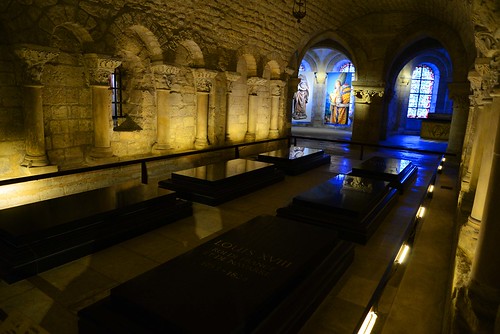We left Versailles early this morning (never really know about traffic) and got to the Paris flat by 8:15am. At 9:00am we were met by the owner and after an orientation and fixing some Wi-Fi issues, we were off on our first day in Paris (after a visit to the local supermarket).
Despite all of the pre-trip planning, once you get to the city, it seems to throw you off. So instead of following a particular preplanned walking tour, you find yourself chasing dead people. We ended up in three cemeteries, one ossuary, and a necropolis.

Our first stop was St. Denis Cathedral. This is the historic necropolis of the French monarchy. The first king, Clovis, is buried here as well as Saint Denis, patron saint. The original crypt dates back to 400. With the exception of two or three kings, every French king is buried here. Well, sort of. During the French Revolution, the revolutionaries suggested to the citizens that they destroy anything having to do with the monarchy. So beginning in 1793, the destruction began. One of the beneficiaries of these misguided actions were the remains of the kings and their families in St. Denis. The crypts and coffins were opened and the remains were either thrown into a large pit or the river. Not to despair because the bones were retrieved after the Revolution. Unfortunately, no one knew whom he or she belonged to. So they just gathered them all up and buried them behind a wall.
Next up was the tomb of Heloise and Abalard. Their story was the Romeo and Juliet of the medieval ages. Interesting story because Heloise’s uncle didn’t like the fact she was going with a much older Abalard so he had poor Abalard castrated. She was sent away to a convent and he continued doing what he did best. Their remains traveled quite a bit over the centuries and it was not until the 1800’s that they were finally brought together and buried side-by-side in the Père Lachaise cemetery.
I could have sworn that Charles-Henri Sanson was buried in Montparnasse Cemetery. We got there and couldn’t find his name on the map. So we started looking for that needle in a haystack. I just figured they didn’t want to put the six generations of royal executioners next to any one. But no, I was wrong. He and the family were buried in Montmartre cemetery.

We finally found Charles-Henri’s grave site (he was listed on the map in District 20; #46 as a “bourreaux”). It was a small grave and the tombstone had weathered poorly. I was able to make out the name at the top, which was the first generation of executioners, Charles-Henri’s great-grandfather, Charles. The last of the six generations was at the bottom – Henri-Clement Sanson. They must all lie on top of one another. Charles-Henri executed Louis XVI prior to retiring when nine-months later, his son, Henri executed Marie Antoinette. Henri-Clement (Henri’s son) lost his job when the government found out he sold the guillotine in 1848 to payoff his debts.
Do we have a lot of stories? Of course we do. I’m looking forward to sharing these with you. Please continue to visit our blog.
Thanks so much for following my blog and my little journey through this incredibly interesting process of writing a book and then getting the bloody thing published.
-Stew
Share This:
Follow Stew:
Find Stew’s books on Amazon and iBooks.
Please note that we do not and will not take compensation from individuals or companies mentioned or promoted in the blogs.
Walks Through History
Copyright © 2013 Stew Ross
